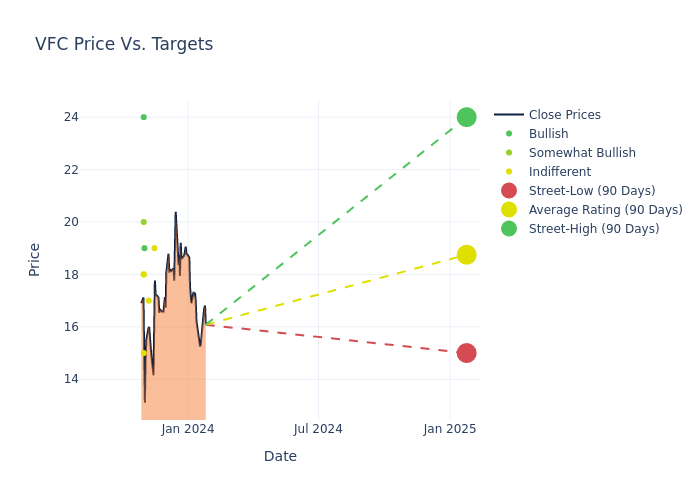In the latest quarter, 8 analysts provided ratings for VF VFC, showcasing a mix of bullish and bearish perspectives.
The table below summarizes their recent ratings, showcasing the evolving sentiments within the past 30 days and comparing them to the preceding months.
| Bullish | Somewhat Bullish | Indifferent | Somewhat Bearish | Bearish | |
|---|---|---|---|---|---|
| Total Ratings | 2 | 1 | 5 | 0 | 0 |
| Last 30D | 0 | 0 | 0 | 0 | 0 |
| 1M Ago | 0 | 0 | 0 | 0 | 0 |
| 2M Ago | 0 | 0 | 0 | 0 | 0 |
| 3M Ago | 2 | 1 | 5 | 0 | 0 |
Analysts have set 12-month price targets for VF, revealing an average target of $18.75, a high estimate of $24.00, and a low estimate of $15.00. A negative shift in sentiment is evident as analysts have decreased the average price target by 15.31%.

Deciphering Analyst Ratings: An In-Depth Analysis
The standing of VF among financial experts is revealed through an in-depth exploration of recent analyst actions. The summary below outlines key analysts, their recent evaluations, and adjustments to ratings and price targets.
| Analyst | Analyst Firm | Action Taken | Rating | Current Price Target | Prior Price Target |
|---|---|---|---|---|---|
| Matthew Boss | JP Morgan | Raises | Neutral | $19.00 | $15.00 |
| Michael Binetti | Evercore ISI Group | Announces | In-Line | $17.00 | - |
| Brooke Roach | Goldman Sachs | Lowers | Buy | $19.00 | $24.00 |
| Abbie Zvejnieks | Piper Sandler | Lowers | Neutral | $18.00 | $20.00 |
| Jim Duffy | Stifel | Lowers | Buy | $24.00 | $27.00 |
| Simeon Siegel | BMO Capital | Lowers | Market Perform | $18.00 | $22.00 |
| Tom Nikic | Wedbush | Lowers | Neutral | $15.00 | $20.00 |
| Dana Telsey | Telsey Advisory Group | Lowers | Outperform | $20.00 | $27.00 |
Key Insights:
- Action Taken: Analysts frequently update their recommendations based on evolving market conditions and company performance. Whether they 'Maintain', 'Raise' or 'Lower' their stance, it reflects their reaction to recent developments related to VF. This information provides a snapshot of how analysts perceive the current state of the company.
- Rating: Unveiling insights, analysts deliver qualitative insights into stock performance, from 'Outperform' to 'Underperform'. These ratings convey expectations for the relative performance of VF compared to the broader market.
- Price Targets: Analysts navigate through adjustments in price targets, providing estimates for VF's future value. Comparing current and prior targets offers insights into analysts' evolving expectations.
To gain a panoramic view of VF's market performance, explore these analyst evaluations alongside essential financial indicators. Stay informed and make judicious decisions using our Ratings Table.
Stay up to date on VF analyst ratings.
Delving into VF's Background
VF designs, produces, and distributes branded apparel, footwear, and accessories. Its apparel categories are active, outdoor, and work. Its portfolio of about a dozen brands includes Vans, The North Face, Timberland, Supreme, and Dickies. VF markets its products in the Americas, Europe, and Asia-Pacific through wholesale sales to retailers, e-commerce, and branded stores owned by the company and partners. The company has grown through multiple acquisitions and traces its roots to 1899.
Understanding the Numbers: VF's Finances
Market Capitalization Analysis: The company's market capitalization is above the industry average, indicating that it is relatively larger in size compared to peers. This may suggest a higher level of investor confidence and market recognition.
Decline in Revenue: Over the 3 months period, VF faced challenges, resulting in a decline of approximately -1.5% in revenue growth as of 30 September, 2023. This signifies a reduction in the company's top-line earnings. In comparison to its industry peers, the company stands out with a growth rate higher than the average among peers in the Consumer Discretionary sector.
Net Margin: The company's net margin is below industry benchmarks, signaling potential difficulties in achieving strong profitability. With a net margin of -14.85%, the company may need to address challenges in effective cost control.
Return on Equity (ROE): VF's ROE falls below industry averages, indicating challenges in efficiently using equity capital. With an ROE of -18.3%, the company may face hurdles in generating optimal returns for shareholders.
Return on Assets (ROA): VF's ROA is below industry averages, indicating potential challenges in efficiently utilizing assets. With an ROA of -3.32%, the company may face hurdles in achieving optimal financial returns.
Debt Management: VF's debt-to-equity ratio stands notably higher than the industry average, reaching 3.53. This indicates a heavier reliance on borrowed funds, raising concerns about financial leverage.
The Core of Analyst Ratings: What Every Investor Should Know
Experts in banking and financial systems, analysts specialize in reporting for specific stocks or defined sectors. Their comprehensive research involves attending company conference calls and meetings, analyzing financial statements, and engaging with insiders to generate what are known as analyst ratings for stocks. Typically, analysts assess and rate each stock once per quarter.
Analysts may supplement their ratings with predictions for metrics like growth estimates, earnings, and revenue, offering investors a more comprehensive outlook. However, investors should be mindful that analysts, like any human, can have subjective perspectives influencing their forecasts.
This article was generated by Benzinga's automated content engine and reviewed by an editor.
Edge Rankings
Price Trend
© 2025 Benzinga.com. Benzinga does not provide investment advice. All rights reserved.
date | ticker | name | Price Target | Upside/Downside | Recommendation | Firm |
|---|
Trade confidently with insights and alerts from analyst ratings, free reports and breaking news that affects the stocks you care about.